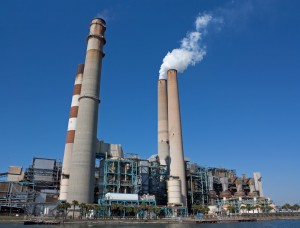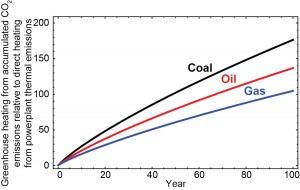2 June 2015
WASHINGTON, D.C. – The heat generated by burning a fossil fuel is surpassed within a few months by the warming caused by the release of its carbon dioxide into the atmosphere, according to a new study published in Geophysical Research Letters, a journal of the American Geophysical Union. The release of carbon dioxide into the atmosphere contributes to the trapping of heat that would otherwise be emitted into outer space.

A new study compares the warming caused by combustion of fossil fuels to the warming caused by the carbon dioxide released by a single instance of burning and by the continuous burning of fuel at a power plant, like this one in Florida. The new study finds that the heat generated by burning a fossil fuel is surpassed within a few months by the warming caused by the release of its carbon dioxide into the atmosphere.
Credit: Wknight94/Wikimedia Commons
When a fossil fuel is combusted, or burned, heat is released. Some of this heat is used to make electricity or heat human-built structures, but eventually all of that energy escapes into the environment and warms the planet. But this combustion process also produces carbon dioxide, which is a greenhouse gas that accumulates in the atmosphere for thousands of years and traps heat that would otherwise escape into space, causing global climate change, according to the study’s authors.
In a modeling study of coal, oil, and natural gas, the study’s authors compared the warming caused by combustion of coal, oil and natural gas to the warming caused by the carbon dioxide released by a single instance of burning each fossil fuel, such as one lump of coal, and by a power plant that is continuously burning fuel.
They found that the carbon dioxide-caused warming exceeds the amount of heat released by a single lump of coal in just 34 days. The same phenomenon is observed in 45 days for an isolated incident of oil combustion, and in 59 days for a single instance of burning natural gas.
“Ultimately, the warming induced by carbon dioxide over the many thousands of years it remains in the atmosphere would exceed the warming from combustion by a factor of 100,000 or more,” said Ken Caldeira, a climate scientist at the Carnegie Institution for Science in Stanford, California, and a co-author of the new study.

This figure shows the ratio of warming from accumulated atmospheric carbon dioxide to warming from combustion for coal, oil, and gas plants over time.
Credit: Xiaochun Zhang/Ken Caldeira
For a power plant that is continuously burning, the warming caused by atmospheric carbon dioxide exceeds the heat released into the atmosphere by combustion in less than half a year for all types of fossil fuels, and in just three months for coal plants. With this kind of steady continuous combustion, it takes 95 days for the warming caused by atmospheric carbon dioxide to exceed the heat released into the atmosphere by combustion using coal, 124 days using oil, and 161 days using natural gas.
“If a power plant is burning continuously, within 3 to 5 months, depending on the type of power plant, the carbon dioxide from the power plant is doing more to heat the Earth than the fires in its boiler,” Caldeira said. “As time goes on, the rate of burning in the power plant stays the same, but the carbon dioxide accumulates, so by the end of the year, the greenhouse gases will be heating the Earth much more than the direct emissions from the power plant.”
Comparing the amount of warming caused by combustion of fossil fuels and the greenhouse gases they produce could help people better understand the magnitude of the greenhouse effect and the impact fossil fuels are having on the Earth, he said.
The energy released by the burning of fossil fuels is now about 1.71 percent of the warming caused by carbon dioxide that has accumulated in the atmosphere as a consequence of historical fossil fuel combustion, according to the new study.
“It’s important to note that heat emissions from combustion are not negligible, particularly in urban areas,” said Xiaochun Zhang, a postdoctoral researcher at the Carnegie Institution for Science, and lead author of the new study. “But carbon dioxide-caused warming is just that much greater. Our results drive home the urgency of cutting emissions immediately.”
Funding for this work was provided by the Fund for Innovative Climate and Energy Research (FICER) and the Carnegie Institution for Science.
###
The American Geophysical Union is dedicated to advancing the Earth and space sciences for the benefit of humanity through its scholarly publications, conferences, and outreach programs. AGU is a not-for-profit, professional, scientific organization representing more than 60,000 members in 139 countries. Join the conversation on Facebook, Twitter, YouTube, and our other social media channels.
Notes for Journalists
Journalists and public information officers (PIOs) of educational and scientific institutions who have registered with AGU can download a PDF copy of the article by clicking on this link: http://onlinelibrary.wiley.com/doi/10.1002/2015GL063514/abstract?campaign=wlytk-41855.5282060185
Or, you may order a copy of the final paper by emailing your request to Nanci Bompey at [email protected]. Please provide your name, the name of your publication, and your phone number.
Neither the papers nor this press release is under embargo.
“Timescales and Ratios of Climate Forcing due to Thermal versus Carbon Dioxide Emissions from Fossil Fuels”
Authors:
Xiaochun Zhang and Ken Caldeira, Department of Global Ecology, Carnegie Institution for Science, Stanford, California, USA.
Contact Information for the Authors:
Ken Caldeira: [email protected], +1 (650) 704-7212
Xaiochun Zhang: [email protected]
Nanci Bompey
+1 (202) 777-7524
[email protected]
Carnegie Science Contact:
Natasha Metzler
+1 (202) 939-1142
[email protected]